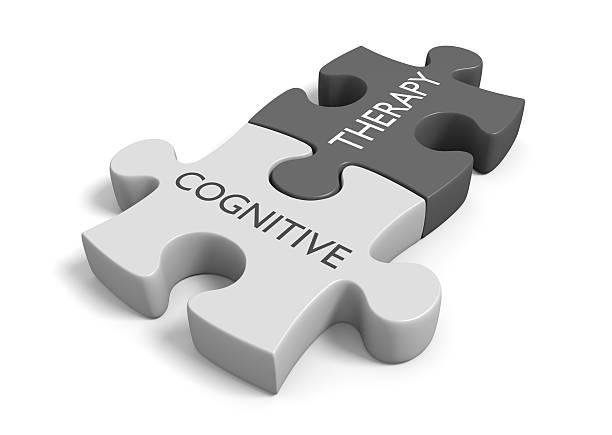CBT for Anxiety

Cognitive Behavioral Therapy (CBT) is a common treatment for mental health conditions such as anxiety. It is often the first course of action for treatment of anxiety before resorting to medication. For some, this therapy is all that is necessary to combat the negative symptoms of anxiety. For others, this therapy- in partnership with medication- can be the perfect solution.
How does it work?

Cognitive-behavioral therapy functions by identifying and addressing how individuals’ behaviors and thoughts interrelate to cause panic. This is usually done by pairing the source of panic with a behavior that is the opposite of anxiety, called a “safety behavior.” People with anxiety disorders typically perform safety behaviors in anxiety-inducing situations. These behaviors may help people cope, but they prolong and exacerbate the illness. For example, someone who is anxious about flying and experiences severe panic attacks every time he gets on an airplane may feel better if he takes medication for his flights or drinks alcohol before he boards. But the medication or alcohol helps him avoid panic at the moment but will not address any issues he has with flying in the long term.
CBT is based on many principles and techniques. Still, the main way that cognitive-behavioral therapy addresses anxiety is by interrupting automatic thoughts and behaviors that prevent people with anxiety disorders from dealing with their situations effectively. Many common methods used in cognitive behavioral therapy are based on operant conditioning. A common example of this is “comparison. ” In comparison, the phrase “I am not as good as my brother” might be replaced by “He is such a good athlete.” Regardless of the purpose, all comparisons reinforce anxiety.
CBT is focused on the present moment; in other words, it is designed to help people become more aware of their current situations and prevent them from being trapped by thoughts that disrupt this awareness. Cognitive-behavioral therapy encourages people to identify and challenge negative thought processes and behaviors that only serve to induce anxiety.
Treating Anxiety with CBT

Cognitive-behavioral therapy helps people develop a new way of thinking and acting in the present moment. They learn to recognize when negative thoughts arise and interrupt these thoughts before they have time to develop into automatic behaviors. Many cognitive behavioral therapy techniques reduce the frequency or impact of specific negative thoughts without affecting the effectiveness of other helpful thoughts that arise during therapy.
Cognitive-behavioral therapy effectively treats anxiety disorders because it addresses how panic and fear-based patterns interfere with effective problem-solving, leading to more anxiety. Cognitive-behavioral therapy helps people identify these problems and how they affect their panic, allowing them to challenge these automatic thoughts and behaviors more effectively.
There is considerable research supporting the effectiveness of cognitive-behavioral therapy for anxiety disorders. The National Institute for Clinical Excellence (NICE) has stated that the best evidence for this treatment comes from randomized controlled trials (RCTs), the most rigorous studies that can be performed. However, it is still possible to draw inferences from non-RCT studies and RCTs.
The most rigorous studies show the benefit of cognitive-behavioral therapy for anxiety. For example, two weeks of cognitive-behavioral therapy resulted in fewer panic attacks in an RCT of medication-free adults with panic disorder. They increased quality of life compared to medication alone. Similarly, a large non-RCT study suggested that cognitive behavioral therapy reduced panic and improved cognition in people with generalized anxiety disorder.
CBT techniques for anxiety

There are many different techniques in cognitive behavioral therapy, but they generally fall under four different methods: cognitive restructuring, exposure therapy, cognitive therapy, and social skills training.
Cognitive restructuring
Cognitive restructuring seeks to identify and restructure situations that lead to negative thoughts. For example, a person with social phobia may deal with negative self-talk by having a friend talk them through the situation by text or phone. The cognitive restructuring allows people with anxiety disorders to develop new thought processes that will help them overcome their negative thought patterns.
Exposure therapy
Exposure therapy is a form of cognitive restructuring in which the individual with panic faces a feared situation. It is not an attempt to make people feel anxious but to reduce the severity of their panic over time. For example, someone with social phobia may first look at pictures in magazines of groups of people together and then be “graded” on how well he does; this often leads to improvements in social skills.
Cognitive therapy
Cognitive therapy encourages people to challenge their negative thought processes by rationally looking at situations. For example, someone who panics in front of an audience may benefit from identifying the irrational nature of their fear and separating it from the situation.
Social skills training
Social skills training helps people with anxiety disorders overcome a strong fear of social situations and develop social skills. For example, someone might attend small parties to get comfortable being around others. It is not an attempt to change the person’s personality but works on specific issues that contribute to panic.
In general, the focus of CBT for anxiety is on the present moment. One of the only common techniques for dealing with past situations is exposure therapy. The rest of the CBT techniques are designed to help people become more aware of their thoughts and act in response to these thoughts without being trapped by them in the future.
Conclusion

Cognitive-behavioral therapy is an effective treatment for anxiety disorders and is currently one of the most popular forms of therapy for these conditions. It can be used as a treatment or as part of a wider program that incorporates physical activity and exercises into the daily routine.
Are you struggling with anxiety? But you don’t have the resources, or tools, to deal with it? Worry no more! Visit Silver Creek for a CBT Consultation, and get the help you need!